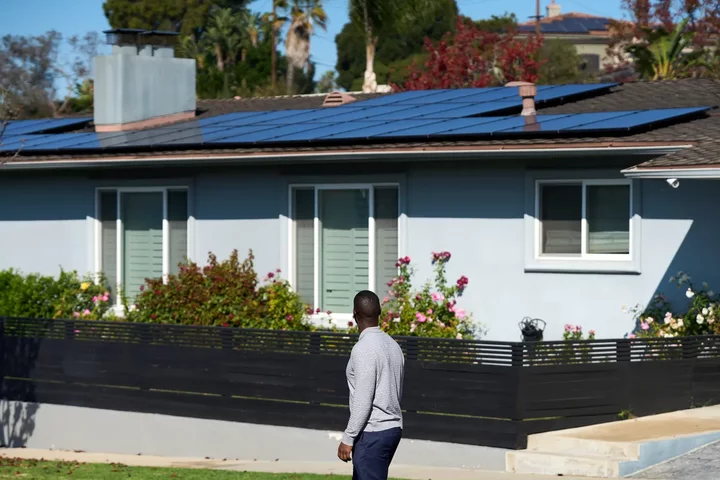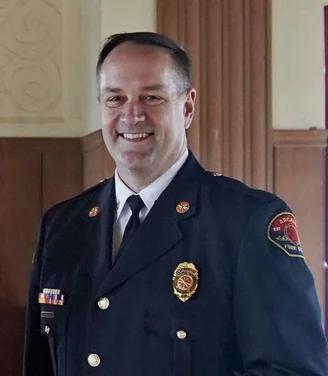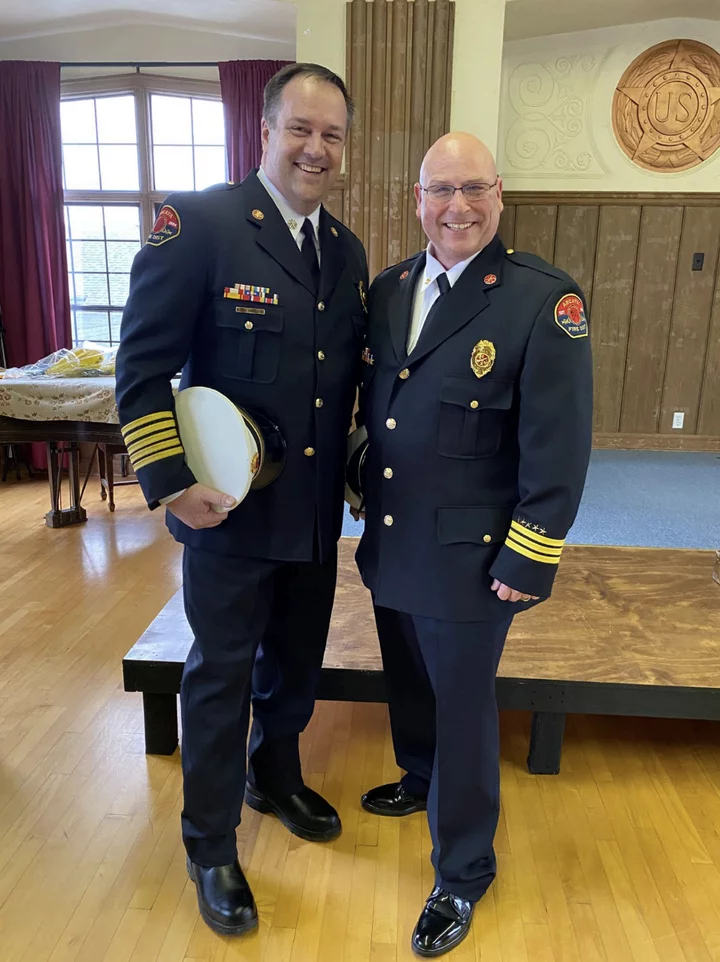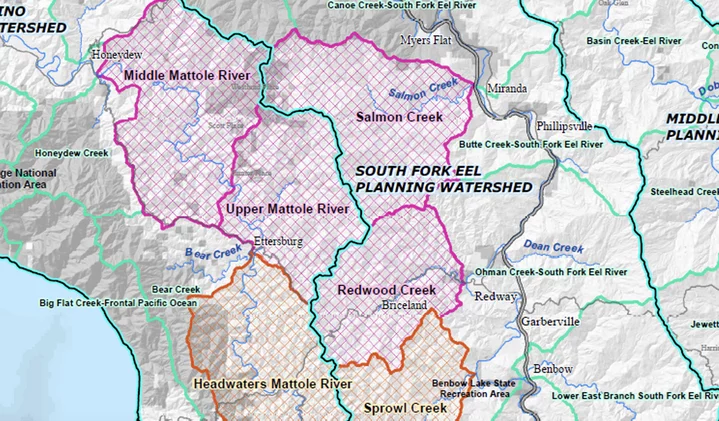Humboldt County Officials Headed to Massachusetts Next Week to Check Out Vineyard Offshore’s Wind Farm
Isabella Vanderheiden / Friday, April 19 @ 11:08 a.m. / Offshore Wind
Photo: Nicholas Doherty via Unsplash.
###
Dozens of Humboldt County officials and local stakeholders are headed to the East Coast next week for a firsthand look at Vineyard Wind 1, the first commercial-scale offshore wind farm in the United States. The trip will give local leaders a chance to meet with the whole Vineyard Offshore team and learn more about some of the challenges associated with offshore wind development – as well as some of the perks – from communities that have already gone through the planning process.
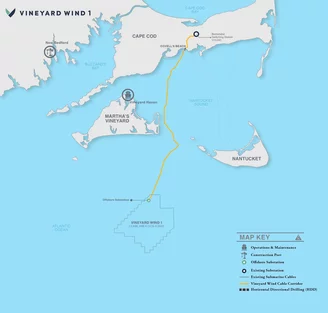
Map of Vineyard Wind 1. Image: Vineyard Offshore (Click to Enlarge)
The project, located about 35 miles off the coast of mainland Massachusetts, is well underway. Earlier this year, the developers, who are planning to build a floating offshore wind farm here on the North Coast, completed the first phase of Vineyard Wind 1 following the installation of five fixed-bottom turbines – each capable of generating 13 megawatts of electricity. The turbines are operating at full capacity and generating enough energy to power 30,000 homes, according to a press release from Massachusetts Gov. Maura Healey’s office.
Reached for additional information about the upcoming excursion, county spokesperson Catarina Gallardo said around 30 local “offshore wind delegates” are expected to go on the trip, including Supervisor Natalie Arroyo and Michelle Bushnell, County Administrative Officer Elishia Hayes, Economic Development Director Scott Adair, members of the Humboldt Bay Harbor, Recreation and Conservation District and city representatives from Arcata, Eureka and Fortuna, among others. Staff from the Governor’s Office of Business and Economic Development will also be in attendance. A complete list of the offshore wind delegation can be found here.
“The purpose of this trip is to gain a real-life practical view and understanding of offshore wind development in Massachusetts so local leaders will have the opportunity to make more informed decisions in Humboldt County regarding offshore wind,” Gallardo told the Outpost. “It is crucial for the county to understand offshore wind processes in other communities to evaluate their applicability in our own community.”
The delegation will also have an opportunity to “hear actionable advice and strategies that could be adapted for local implementation and solicit feedback on what more experienced communities would do differently if given the chance,” she added.
The county secured a $1.5 million Federal Workforce Information Opportunity Act grant through the California Employment Development Department to send staff on the trip. The grant funds will also cover an upcoming trip to Hull, England where delegates will attend the Offshore Wind Connections 2024 Annual Conference. [CORRECTION: Although the grant award covers international travel, the delegation will not travel to England this year, Gallardo told the Outpost in a follow-up statement.]
When the delegation returns, they’ll work with county staff to produce a detailed report summarizing their trip that will be presented to the Humboldt County Board of Supervisors.
BOOKED
Today: 6 felonies, 14 misdemeanors, 0 infractions
JUDGED
Humboldt County Superior Court Calendar: Today
CHP REPORTS
No current incidents
ELSEWHERE
Governor’s Office: Governor Newsom Proclaims Jewish American Heritage Month 2024
Governor’s Office: Governor Newsom Proclaims Wildfire Preparedness Week 2024
Governor’s Office: At the Top of the Golden Gate Bridge, Governor Newsom Announces Tourism Spending Hit an All-Time High in California
Colorado Sun: A billionaire’s fence is the latest fault line in a 150-year-old San Luis Valley land war
DUDE, HUMANS CAN FLY! Coast Guard Chopper to Touch Down at Cal Poly Humboldt on 4/20 to Raise Awareness of Aviation
LoCO Staff / Friday, April 19 @ 10:55 a.m. / Education
Pretty trippy when you think about it. File photo: Andrew Goff.
Press release from Cal Poly Humboldt:
To provide students an opportunity to access and learn about aviation, Cal Poly Humboldt’s student-led Aviation Club will be hosting a special event with the U.S. Coast Guard.
The Coast Guard will land a helicopter at Cal Poly Humboldt. The event is free to attend for people of all ages.
The Aviation Club was established in 2020. The club aims to lower barriers for students interested in aviation by helping prepare students to take their drone pilot license test, and by offering training on the University’s flight simulator (located on the second floor of the Library).
- What: Coast Guard Landing (weather permitting)
- Who: Cal Poly Humboldt Aviation Club
- When: Saturday, April 20, starting at 11 a.m.
- Where: Cal Poly Humboldt, parking lot (G11) at LK Wood and Harpst Street.
The event is weather dependent.
The eastern portion of the lot and Rossow Street (from Harpst Street to the Parking Kiosk in front of the Student & Business Services) will be closed to parking and traffic. G11 will still be accessible from LK Wood.
A Plan to Change Your Utility Rates Is Dividing California Environmentalists. Here’s Why
Ben Christopher / Friday, April 19 @ 7 a.m. / Sacramento
Ken Wells of O&M Solar Services in Los Angeles, outside a home with solar panels in Ladera Heights. Photo by Lauren Justice for CalMatters
On May 9, the California Public Utilities Commission is scheduled to vote on whether to let the state’s largest power providers slap most customers with a new fixed charge. Think of it like paying for a subscription service, except instead of forking over a monthly fee to watch old Friends episodes, this one lets you enjoy the comforts of 20th century living.
Also, according to the proposed rule, the utilities will be required to lower the rate we all pay for each unit of power we consume.
On average, electric bills won’t go up or down, but most households aren’t exactly average. Under the proposed change, people who use less electricity will pay a bit more as a result of the fee, while those who rack up large power bills will save thanks to the lower usage rates.
The basic idea isn’t novel, even if it’s wildly controversial here in California; Most utilities across the country already collect fixed charges. But this proposed regulation comes with a distinctly California twist: The fixed charges would vary by income, with higher earners paying a $24 fee and lower-income households paying either $6 or $12.
The proposed charges are significantly less steep than ones proposed by the utilities themselves last spring, which topped out at $128 per month for the highest earners. But with a national average of roughly $11 per month, the $24 fee under consideration is still on the high end. Though most households will be compensated, at least partially, through lower rates, that sticker shock has engendered plenty of political outrage.
Republicans don’t like it because the income-varying nature of the charge smacks of a progressive income tax. Many Democrats have lambasted the idea, too, because the lower volumetric rates will water down the incentive to mind one’s electric usage. The utilities say they need some kind of fixed charge to help pay down wildfire and other rising fixed costs.
“Those who consume more electricity, such as a single family home with (a) pool, will receive a discount at the expense of a low electricity user, such as an apartment renter,” wrote Jacqui Irwin, an Assemblymember from Thousand Oaks, along with 21 of her fellow Democratic colleagues last fall.
Irwin is also the lead author of a bill that would put a tight lid on fixed charges, capping them at $10 for most customers and $5 for those enrolled in the state’s biggest energy assistance program.
What makes the debate especially unusual is where some of the state’s most influential environmental interests have come down on the proposal. Namely, on both sides. The Natural Resources Defense Council is for it. Environment California is against it. The Sierra Club called it a “mixed bag.”
Once upon a time, environmental interests shared a united view about the best way to make use of the grid: The less the better.
Now, depending on which green activist you ask, the regulatory proposal is either a utility-backed break from the state’s long, eco-conscious tradition of encouraging energy conservation, or a necessary first step toward electrifying our homes and vehicles for the sake of the planet’s future.
“Ten years ago, even, the grid was mostly powered by fossil fuels,” said Mohit Chhabra, an analyst with the Natural Resources Defense Council, which backs the proposed change. “The question now, as the grid gets cleaner, is ‘When should you use more?’”
As the commission prepares for its vote early next month, the debate is the latest sign that the changing economics of electricity generation in California are beginning to upend the traditional politics of the grid as well.
The case for a fixed charge
The origin of the current debate dates back to at least 2021 when three UC Berkeley energy economists published a report on what’s wrong with California’s electricity prices.
The report is heavy on jargon, but the gist is simple: Rates are just way too high.
Severin Borenstein, one of the report’s authors, said that isn’t a populist argument; it’s an economic and environmental one. Providing energy through the state’s increasingly solar- and wind-saturated electric grid is not only cheaper, but vastly more environmentally friendly than getting an equivalent amount of energy by burning gasoline or methane.
But because California has some of the highest retail electric rates in the country, “the cost of fueling my Prius at a gas station is about the cost of fueling a Tesla — and it shouldn’t be,” he said. “We are sending entirely the wrong price signals and it’s undermining decarbonisation.”
The reason for the gap between the price California households pay and the actual cost of producing the energy, Borenstein argues, is that many of the costs that large utilities face — costs that have nothing to do with actually producing electricity — are larded onto the rates we pay per kilowatt hour. Those costs include paying off wildfire-related lawsuits, investments intended to ward off future fires, rebates for lower-income customers, electric vehicle charging stations, payments to customers with rooftop solar panels and upkeep of the grid itself.
The utilities say they need some kind of fixed charge to help pay down wildfire and other rising fixed costs.
The best way to pay for many of these costs would be out of the state budget, Borenstein argues — a political nonstarter. The report suggested an alternative: Cut rates and make up the difference with a fixed charge on every electric bill. Better yet, for the sake of fairness, make the fixed-charge vary by household income — an income tax of sorts, but paid monthly to the utilities.
Customers would still be on the hook, the argument goes, but at least bills would do less to discourage Californians from buying electric cars and induction stoves.
The next year Gov. Gavin Newsom’s revised budget proposal included language that would let the state’s utility regulator do just that. An income-graduated fixed charge, the budget document read, would “enable creation of better price signals that will enhance widespread electrification efforts.”
A month later, that measure was tucked in a 21,000-word budget bill with little public discussion. It wasn’t until late last year, after the public utility commission began soliciting feedback on the proposal it had been tasked by the Legislature to come up with, that legislators began sounding the alarm and introducing new legislation to reverse course.
Newsom’s office declined to comment on the current legislation. But in January, a spokesperson for the administration told reporters that the governor “looks forward to seeing a commission proposal that is consistent” with the 2022 budget bill language
Electrification vs. conservation
It’s not a coincidence that utilities in eco-conscious, politically blue California are rare among the nation’s power providers in doing without fixed charges. Sticking high energy users, believed to be higher income households, with more of the bill has always appeared to align with the state’s economically progressive bent. Charging more per unit of electricity also promotes energy efficiency.
Environmental advocates who oppose the change aren’t keen on lessening the current financial penalty for being an energy hog.
“It’s going to have this perverse impact of incentivizing wasting energy, encouraging people to buy the biggest car, the biggest house, leaving the lights on,” said Laura Deehan, state director of Environment California, at a digital press conference on Tuesday. The change would also further discourage the uptake of rooftop solar panels, she warned.
It’s already been a punishing few years for the rooftop solar industry in California. In 2022, the public utilities commission cut the payment that panel owners receive for the excess energy they pipe back onto the grid. By lowering the per-unit cost of electricity that panel owners forgo, this year’s change would further chip away at the benefit of going solar, while also sticking those households with an unavoidable monthly fee.
“High fixed charges pick winners and losers,” explained Bernadette Del Chiaro, executive director of the California Solar & Storage Association, in an email. “The winners are high energy users. The losers are low energy users. Adding solar and batteries to your home can also make you a low energy user. So, yes, we have a dog in the fight.”
“But the numbers of non-solar users impacted by this are much larger,” she said.
Winners and losers
Who those affected customers are is its own spirited debate. The biggest losers will be middle income households who just miss the cut-off for a discount and who currently have small energy bills. The biggest winners will be the biggest users.
“High usage customers tend to be wealthier people who can afford to pay these energy bills,“ said Josh Plaisted, founder of the engineering and regulator consulting firm Flagstaff Research, which conducted analysis of the proposed change for the Clean Coalition, a nonprofit that promotes policies that support rooftop solar, microgrids and other non-utility-based energy systems.
Under the fixed charge proposal, “a home with a backyard pool in Walnut Creek is rocking it,” he said.
Supporters counter that while higher income households do tend to use more energy, the relationship isn’t as consistent as one might think.
Of all the things that determine whether a house uses a lot of energy or a little, income isn’t as important as local climate, household size and the efficiency of the building, said Chhabra. Wealthier families are more likely to have better insulated homes, solar panels on their roofs and live in expensive coastal cities, all of which tend to result in lower electric bills.
“Once you start looking through the details, a generic assumption like that just doesn’t hold,” he said.
The CPUC estimates that a typical household that goes fully electric would save between $12 and $19 per month on their electric bill as a result of the new rate change.
For now the debate may be more symbolic than meaningful. While the biggest winners and losers under the proposed policy stand to see their yearly utility spending change by a few hundred dollars, both supporters and opponents concede that most customers will fall somewhere in the middle. Many may not even notice the change. Meanwhile, the change won’t affect commercial or industrial customers at all.
That’s not enough to break the bank for most, but nor is it likely to make the difference for a household weighing a gas versus an electric hot water heater. “Connecting the fixed charge with ‘this enables electrification’ just rings hollow,” said Plaisted.
The CPUC estimates that a typical household that goes fully electric — swapping out its gas-powered space and water heaters, its oven and its dryer with grid-powered alternatives — would save between $12 and $19 per month on their electric bill as a result of the new rate change.
Chhabra argued that the effect that a reduced rate will have on conservation is also likely to be negligible. California’s electric prices are“ still the highest in the country, save Hawaii, right?” he said. “So there’s still enough signal there.”
But as California continues its campaign to wean itself off fossil fuels, the divide among environmental advocates and other members of the Democratic coalition who shape state energy policy isn’t likely to go away anytime soon.
“We are trying to balance conservation, efficiency, electrification and fairness,” said Chhabra. “And you can’t give the best thing for everything all at once.”
###
CalMatters.org is a nonprofit, nonpartisan media venture explaining California policies and politics.
OBITUARY: Linda Lou Walker, 1946-2024
LoCO Staff / Friday, April 19 @ 6:56 a.m. / Obits
Linda
Lou Walker was born on January 22, 1946 to Beverly and
Gordan Ashcraft, in Red Bluff. She passed away March 29, 2024, after
a short battle with cancer, holding her husband Melvin Walker and son
Albert Kutzkey’s hands at The Hospice House in Eureka.
Linda is survived by her loving husband Mel, son Albert and his wife Deborah and granddaughter Aundie, her daughter Bernadette Speth, husband Blair and grandchildren Allison and Sierra, stepdaughter Leslie Westpremi, husband John and grandchildren Wyatt & Kayla, stepdaughter Laurie Hill, husband Steve and grandchildren Emily & Neel, stepson Jeff Walker and her sisters Judy Amrein and Karen Logan and brother Dale Ashcraft.
Linda grew up in Little Shasta Valley and attended Yreka High School. She lived in various places in California and did a variety of jobs, including being a fuel truck driver for a helicopter. Linda moved to Arcata, and that is where she met Mel Walker and they were married October 1999. They have lived in Blue Lake for over 25 years.
Linda was a fun spirited soul who had many passions. She had incredible artistic skills and talents and loved painting, sewing, macrame and jewelry making. She enjoyed camping, being outdoors, puzzles and reading. She especially loved working outside with all her beautiful flowers and watching all the hummingbirds zipping in and out of her flower garden!
Linda was known to be a “tell it like it is” person. She cared so deeply for the people around her and made an impact on many lives. She will be forever missed by so many. Until we meet again …
Many special thanks to Hospice for their tremendous support to Linda and her family.
###
The obituary above was submitted on behalf of Linda Walker’s loved ones. The Lost Coast Outpost runs obituaries of Humboldt County residents at no charge. See guidelines here.
Arcata Fire District Chief Announces Retirement; New Chief Named
LoCO Staff / Thursday, April 18 @ 4:17 p.m. / Fire
Arcata Fire District press release:
Arcata Fire District Fire Chief Justin McDonald has announced his retirement beginning June 26, 2024.
Chief McDonald’s retirement marks the end of an era for the Arcata Fire District after three decades of dedicated service. His journey from volunteer firefighter to Fire Chief is a testament to his passion and commitment to serving the community. McDonald’s family ties to the district and his personal dedication have left an indelible mark on the organization.
“It has been a gift to be part of the fire service and this organization. I am extremely proud of the men and women of Arcata Fire District who do amazing work and serve the people of Humboldt County with both passion and compassion. The past 30 years I have spent in the fire service have transformed my life, and I have no regrets,” McDonald said.
Under his leadership, the Arcata Fire District has thrived, providing essential services to over 36,000 residents in the greater Arcata area. McDonald’s emphasis on collaboration and resource management has ensured the safety and well-being of both firefighters and the public.
“Since starting as a volunteer firefighter over 30 years ago, Justin has shown outstanding commitment and dedication to the Arcata Fire District and its citizens. He has our gratitude and appreciation for his devotion to the duties and obligations he has faithfully fulfilled,” said retired Fire Chief Dave White – who hired McDonald when he became a full-time firefighter.
Chief Justin McDonald and Assistant Chief Chris Emmons
The board’s selection of Deputy Chief Chris Emmons as the next Fire Chief speaks to McDonald’s commitment to succession planning within the organization. With almost 32 years of experience in the fire service, Emmons will undoubtedly continue McDonald’s tradition of excellence, guided by the example set by his predecessor.
As McDonald prepares to step down, his colleagues and community members reflect on his remarkable career with admiration and gratitude. His unwavering dedication and steadfast leadership have left an enduring legacy of excellence within the Arcata Fire District.
“As a member of the board of directors for the Arcata Fire District for nearly four years now, I can truly say it has been a pleasure to work with Chief McDonald. He helped shepherd the district through some fairly dark times when funding was inadequate, and the district was losing experienced firefighters to other fire agencies. He has been at the forefront of modernizing the district and preparing for a future where our community has an increased population, taller buildings and the threat of longer fire seasons. Because of the communities passing of Measure F, Chief McDonald’s dogged determination as well as his ability to work with the Arcata Professional Firefighters Local 4981 and the board, the fire district is better now than when he was made chief. Chief McDonald’s ability to manage crises big and small, as well as plan for the future even in times of budgetary uncertainty will be greatly missed.
On the upside, Chief McDonald has promoted and hired highly capable Chief Officers that will most certainly continue to serve this
community proudly,” said Arcata Fire Board Director Blaine Maynor.
Arcata Fire Board Director Nicole Johnson said, “Through decades of steadfast leadership and unwavering commitment, Chief McDonald has shaped a legacy of excellence that will continue to inspire generations of firefighters. His dedication to duty and passion for service will forever remain a beacon of strength within our department.”
The Coming of May Means That Calfire Burn Permits Will Again be Required in the State Responsibility Areas
LoCO Staff / Thursday, April 18 @ 3:25 p.m. / Fire
Photo: Calfire.
Press release from the Calfire Humboldt-Del Norte Unit:
The California Department of Forestry and Fire Protection (CAL FIRE) Humboldt – Del Norte Unit has announced effective at 6:00 AM, May 1st, 2024, all hazard reduction burning will require a permit in the State Responsibility Areas of Humboldt and Del Norte Counties. A North Coast Unified Air Quality Management District (NCUAQMD) burn permit is required any time you burn vegetation. NCUAQMD burn permits can be obtained online at www.ncuaqmd.org, or in person at 707 L Street, Eureka (M-F 9am to Noon and 1pm to 4pm). For more information contact the NCUAQMD by calling (707) 443-3093.
CAL FIRE burn permits must now be obtained online at https://burnpermit.fire.ca.gov/. Applicants can access the website to obtain a burn permit which involves watching a short educational video and submitting an application. The process provides the necessary information needed to conduct the burn safely, while minimizing the chance for fire escape. Permits must be in possession either by printed copy or digitally.
Permits are valid beginning May 1st of each year and require annual renewal. Permits are issued free of charge.
Property owners conducting hazard reduction burning are responsible for checking the burn day status with the NCUAQMD:
Burn Day Information Line:
- (707) 443-7665, or
- (866) 287-6329 (or 866-BURNDAY)
Burn Zone information is listed on NCUAQMD permit.
Hazard Reduction Guidelines are listed on the CAL FIRE permit and must be followed at all times.
As a reminder, always have a minimum 10-foot clearance down to bare mineral soil around all burn piles, have a shovel and a water source available, and an adult present during burning. Failure to follow these simple precautions may result in a citation and fines. For further information regarding residential burning or other fire safety tips visit your local CAL FIRE Station or go to www.readyforwildfire.org.
Environmental Groups Say County Has Abandoned Its Duty to Fully Assess the Weed Industry’s Impacts
Ryan Burns / Thursday, April 18 @ 11:07 a.m. / Cannabis , Government
Detail of a Humboldt County watershed planning map.
###
A trio of local environmental groups is accusing the county of abandoning its legal obligation to fully assess the impacts of the local cannabis industry on groundwater, wildfire risk, streams, rivers and more.
In a letter submitted yesterday to the Board of Supervisors, the Planning Commission and Planning and Building Director John Ford, leaders of the three groups – Northcoast Environmental Center, Citizens for a Sustainable Humboldt and the Environmental Protection Information Center – say the county must formally ask regulatory agencies to collect and report more data so that the county can comply with a resolution it passed nearly four years ago.
That resolution, No. 18-43, established watershed-specific caps on the number of permits and acres the county can approve for commercial cannabis cultivation, plus an overall cap of 3,500 permits and 1,205 acres. It says the county must conduct an annual review of those limits at noticed public meetings of the Board of Supervisors. Such hearings have never been held.
The letter says that the county, as the lead agency in charge of regulating the industry here in Humboldt, needs to request more information from state and federal agencies including the California State Water Resources Control Board, the California Department of Fish and Wildlife, the Bureau of Land Management and the U.S. Forest Service.
Without that data, the letter says, regulators lack “a robust understanding of the cumulative impacts of industrial cannabis cultivation in each watershed and sub-watershed.”
Asked via email to respond to the allegation that the county has failed to comply with Resolution No. 18-43, Ford offered a brief response that more or less confirmed that to be the case, though the reply implicates other agencies along with the county.
“There has not been adequate reporting as discussed in Resolution 18-43,” Ford wrote in an email.
Below is the full text of the letter, which was sent ahead of next week’s supes’ meeting, at which the board is expected to discuss related issues.
Re: Watershed Analysis / Data Collection & Reporting / Humboldt County Cannabis Ordinance 2.0
To the Humboldt County Board of Supervisors, Humboldt County Planning Commission, and Director Ford:
The County is not following its own Resolution 18-43 and FEIR.
We seek immediate action: the lead agency—the Humboldt County Planning Department—must formally request that watershed monitoring, data collection, and analyses be performed by the appropriate California State and Federal agencies. These include the State Water Board, NCRWQCB, CDFW, CDF, BLM and USFS.
Fulfillment of this request, with necessary reporting in combination with disclosure of data already collected by the County, shall allow for a robust understanding of the cumulative impacts of industrial cannabis cultivation in each watershed and subwatershed. It will make clear the true, on-the-ground environmental and community carrying capacities and parameters… and begin to realize the legal obligations and responsibilities committed to by the County, which have been abandoned.
This formal analysis will inform realistic environmental guidelines, regulations, and other policy, including that for permit allocation and enforcement. It should include:
- Data on roads and traffic, for accurate assessment of impacts to rural infrastructure, public safety, increased burden on first responders, and enhanced risk of wildfire.
- Data from watershed and subwatershed studies and analyses, including temporal monitoring data on stream flow and water quality (e.g. nutrients, temperature, bacteria, sediment, etc.).
- Data regarding impacts of groundwater extraction on surface waters, springs, and seeps.
- Data measuring the scope of industrial level noise and high wattage lights, to assess impacts on wildlife and communities.
- Detailed maps of permitted and pending permit sites—showing pending, active, and lapsed permit location—original and expanded cultivation areas and types, energy sources/generators, water sources/locations, streams and rivers, and roads.
This formal data collection and analysis must be accompanied by reporting at annual public hearings to assess and implement potential caps on cultivation acreage based on real information, as stated in the 2018 Resolution 18-43*…which have never occurred.
In addition to a formal request by the lead agency for this watershed monitoring and data collection, we urge you to develop a specific action plan for implementing its public availability and discussion.
Sincerely,
Larry Glass,
President of the Board of Directors
Northcoast Environmental Center (NEC)
(707) 822-6918
nec@yournec.orgMary Gaterud,
President of the Board of Directors
Citizens for a Sustainable Humboldt (CSH)
(707) 845-2199
marygaterud@gmail.comTom Wheeler,
Executive Director Environmental Protection Information Center (EPIC)
(707) 822-7711
epic@wildcalifornia.com*As per Resolution 18-43: “—analysis of the condition of these planning watersheds, including review of water flow data and applicable studies or information prepared by the following state and local agencies: California Department of Fish & Wildlife, North Coast Regional Water Quality Control Board, State Water Resources Control Board, and the Department of Forestry and Fire Protection…”
“Following the establishment of a countywide cap on the total number of permits and acreage of cultivation that may be approved, beginning in May of 2019, the Board of Supervisors agrees to conduct an annual review of the limits and prescribed distribution of permitting and acreage allowances found in the above table. Review shall occur at noticed public hearings held during a meeting of the Board Supervisors, during which the Board shall receive and consider a report providing an update on local permitting efforts.”
“—detailing the number and status of all applications received, permits approved, compliance agreements that have been executed, and code enforcement actions undertaken by the Department. Law enforcement or other relevant officials from local and state agencies shall be contacted and invited to provide and present input and information to be considered by the Board during annual review. After holding a public hearing and considering all information and testimony received, the Board may choose to establish new caps on acreage and permits as well as change their distribution within watersheds.”
###
DOCUMENT: Resolution No. 18-43



